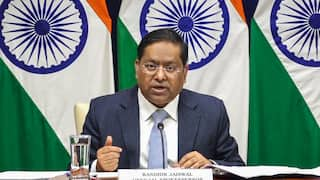Opinion: CJI and PM Row — Judges Should Be Assessed On The Bench, Not On Private Life

‘Vighnaharta’, another name for Lord Ganesh, means ‘one who removes obstacles’. However, a Ganesh Puja at the residence of the Chief Justice of India (CJI), attended by the Prime Minister (PM), has sparked controversy, with the internet up in arms against the Chief Justice. The visit has been criticised as an erosion of the separation of powers, and an act “undermining judicial independence”, given that the government is the largest litigant. Critics argued that such visits undermine the perception of the judiciary being impartial. Some even went so far as to claim that Justice Chandrachud had compromised his legacy.
Scrutiny of public institutions is important, but we must ensure that it is not clouded by ideological or political biases. Unfortunately, the backlash against the Chief Justice reflects not only these biases but also a hyper-technical approach to constitutional principles.
First, separation of powers is a contentious issue in a country like India, where the executive and judiciary frequently cross paths. The Montesquieuan idea behind the principle is to ensure that the state’s different organs — legislature, executive, and judiciary — are occupied by different functionaries and perform distinct functions. However, Montesquieu was not against the occasional overlap of functions, and even encouraged it to ensure necessary checks and balances. The discourse around the separation of powers often forgets that it does not mean a complete lack of interaction between functionaries, but rather that each organ should exercise its designated functions.
Another purpose of the separation of powers is to promote coordination and collaboration between institutions. When decision-making requires collaboration between multiple organs, a decision cannot be taken at the behest of one body alone; consensus and adherence to due process are essential. Any other reading of the separation of powers is not only incorrect but also unnecessarily literal. In India’s context, judicial reforms will remain a distant dream without administrative collaboration. When we view other constitutional concepts liberally and without strict interpretation, why should the separation of these two organs be valued so strictly?
Informal and personal meetings between the heads of the judiciary and the executive are not new in India. When Justice Chagla was Chief Justice of the Bombay High Court, he often met the then Chief Minister Morarji Desai for tea and discussed judicial issues and reforms. Justice Chagla, one of the most prolific judges to date, was very vocal about his political views and appreciated the work done by Prime Minister Nehru. In his book ‘Roses in December’, Justice Chagla states that such meetings foster the healthy growth of judicial infrastructure. A strict reading of the separation of powers fosters the perception that the judiciary should always be at odds with the executive, which would lead to friction between organs and impede reforms.
Second, the claim that the visit compromised judicial independence because the government is the largest litigant reflects a lack of faith in our judges and their ability to exercise judicial powers freely. Judges have repeatedly demonstrated their ability to separate their administrative functions from their judicial ones, sharing a dais with the executive on one occasion and ruling against their policies on another. There is a rising misconception where we perceive the judiciary to be independent only when it disagrees with the executive or strikes down its policies, and term it compliant when it upholds a policy or collaborates with the government. Such a mindset breeds distrust and malice, creating doubt in the minds of citizens about the judiciary.
ALSO READ | How SC Verdict On Article 370 Balances Legal Norms And Political Realities
Criticism Of CJI Driven By Biases
Third, the extreme claim that Justice Chandrachud has discredited his legacy is unwarranted and does a disservice to his distinguished judicial tenure. Chandrachud has served on benches that have rendered decisions critical of the Union government. One such instance is the March ruling by the Supreme Court in the electoral bonds case, which declared the scheme unlawful due to its infringement on voters’ right to information. Additionally, he wrote dissenting opinions in the Aadhaar and Bhima Koregaon cases, where the majority judgments favoured the government. On the other hand, he was in the majority in the Ayodhya and Article 370 judgments, which accepted the Union government’s arguments. Justice Chandrachud has been on both sides; it does not mean that one day he practises judicial independence, and aligns with the executive the next. His judicial tenure indicates that he uses his conscience and adjudicates cases based on the law. To hail him as a crusader for liberty one day and deride him as a compliant judge the next highlights ideological and political biases. Such biases strip objectivity from judicial decision-making and diminish trust in the legal aptitude of a judge. As a result, every action of the judge is viewed through a political or ideological lens.
In addition to his judgments, Justice Chandrachud has also been criticised for wearing religious attire, celebrating festivals, and, in this case, hosting a puja on Ganesh Chaturthi. A judge’s actions should be judged on the bench, not in his personal life. Ideally, a judge leads a life of aloofness, but we must remember that judges are human too, with personal lives. The assessment of a judge’s personal life should come into question only when their actions affect the judiciary and their decisions. The Prime Minister’s visit should be seen as one constitutional functionary visiting another, and nothing more. Justice Chandrachud has consistently demonstrated his commitment to liberty, secularism, and inclusiveness — a legacy that cannot be so easily compromised.
Swapnil Tripathi is a lawyer and pursuing a DPhil at the University of Oxford. Kumar Kartikeya is a legal researcher.
[Disclaimer: The opinions, beliefs, and views expressed by the various authors and forum participants on this website are personal and do not reflect the opinions, beliefs, and views of ABP News Network Pvt Ltd.]


























